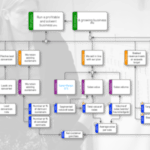Buying rugs and broken broadband connections

There’s something curious happens when you write a number down. It somehow becomes “official”. I realised this a few years ago when haggling for rugs in India. The traders would write down the figure on a piece of paper and show it to you when you were haggling. I naively assumed this was to avoid confusion because of potential language issues, but I realised after a while that many of the traders spoke better English than me. The traders used many subtle (and not-so-subtle) sales techniques that are only now being formally researched and shown to be effective, but this one stuck with me.
A few years later and my cable modem is being fixed (replaced) by a helpful technician from Virgin Broadband. I ask him what it’s like working for Virgin Broadband and he explains how the job is being ruined by his boss’s obsession with beating the 4.2% fault recurrence rate. His boss is demanding a 3.8% rate from all of his technicians. I ask where the target comes from and he explains that he has “no idea” and then goes on to explain that the biggest driver on recurring faults is the type of modem they install – with some models much more likely to fail soon after installation than others. The definition of “recurring” is interesting as well, it’s any issue reported within 7 days of the initial fault, whether related to the initial issue or not.
It seems that two apparently arbitrary targets around recurring faults had become written targets and taken on a level of significance way beyond any justification. They had become “official”. For a better, more reasonable way to set targets, we need to start by understanding motivation and incentives.



![Complete Guide to the OKR Framework: How to Create OKRs for Your Team [2024] okr kpis and targets logo](https://madetomeasurekpis.com/wp-content/uploads/2021/12/okr-kpis-and-targets-logo@2x-150x150.png)


